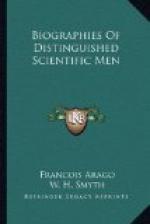Between these two extreme positions, how does the diminution of the emissive power operate? Leslie first sought the solution of this important question. His observations seem to show that the intensities of the radiating rays are proportional (it is necessary, Gentlemen, that I employ the scientific expression) to the sines of the angles which these rays form with the heated surface. But the quantities upon which the experimenter had to operate were too feeble; the uncertainties of the thermometric estimations compared with the total effect were, on the contrary, too great not to inspire a strong degree of distrust: well, Gentlemen, a problem before which all the processes, all the instruments of modern physics have remained powerless, Fourier has completely solved without the necessity of having recourse to any new experiment. He has traced the law of the emission of caloric sought for, with a perspicuity which one cannot sufficiently admire, in the most ordinary phenomena of temperature, in the phenomena which at first sight appeared to be entirely independent of it.
Such is the privilege of genius; it perceives, it seizes relations where vulgar eyes see only isolated facts.
Nobody doubts, and besides experiment has confirmed the fact, that in all the points of a space terminated by any envelop maintained at a constant temperature, we ought also to experience a constant temperature, and precisely that of the envelop. Now Fourier has established, that if the calorific rays emitted were equally intense in all directions, if the intensity did not vary proportionally to the sine of the angle of emission, the temperature of a body situated in the enclosure would depend on the place which it would occupy there: that the temperature of boiling water or of melting iron, for example, would exist in certain points of a hollow envelop of glass! In all the vast domain of the physical sciences, we should be unable to find a more striking application of the celebrated method of the reductio ad absurdum of which the ancient mathematicians made use, in order to demonstrate the abstract truths of geometry.




